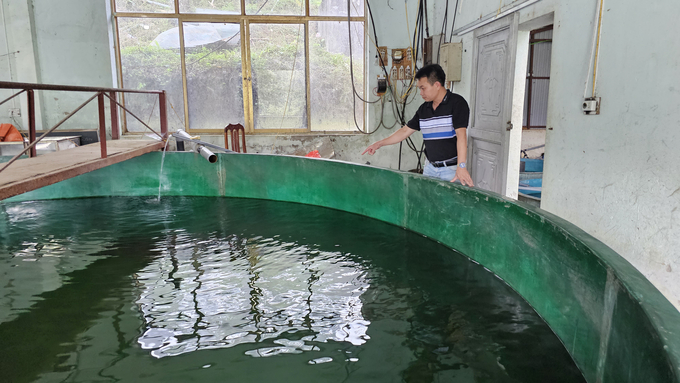November 26, 2025 | 01:04 GMT +7
November 26, 2025 | 01:04 GMT +7
Hotline: 0913.378.918
November 26, 2025 | 01:04 GMT +7
Hotline: 0913.378.918

Lao Cai farmers produce sturgeon breeds to be proactive in terms of production. Photo: H.D.
Coldwater fish farming brings good profits to farmers in Lao Cai. However, there are many risks in the farming process, notably product output. Linkage models have helped farmers feel secure in production, thus ensuring stable output. As a bonus, transparency in the origin and quality of the fish has made Chinese sturgeon and salmon lose their foothold in the local market.
Thuc Mai Cooperative in Can Ho Mong village, Ngu Chi Son commune (Sa Pa town, Lao Cai) not only produces and supplies fish seeds and feed by itself but also works with local farmers, purchasing fish from 30 households. Families participating in the cooperation must commit to strictly comply with the seed, feed, and farming techniques. The purchased fish must be of guaranteed quality with clear origin.
"When producing and doing trades on large quantities of coldwater fish, quality is the number one priority, thereby enhancing business reputation and establishing a long-term position in the market. The cooperative's products must be clean and safe to consume," said Pham Thi Mai, manager of Thuc Mai Cooperative.
The cooperative has have more than ten OCOP-certified salmon and sturgeon products favored by the market, such as Sa Pa salmon floss, Sa Pa salmon cut into pieces, Sa Pa salmon fillets and Sa Pa smoked salmon. Thuc Mai Cooperative aims to further improve in terms of quality, packaging design, solidifying the position of salmon products of Sa Pa in particular and Lao Cai in general.
Having more than 100 ponds, Song Nhi coldwater fish farm is coordinating with Sa Pa Town Farmers' Union to support farmers in accessing low-interest loans for production and business, and at the same time transferring science and technology in fish farming.
Tran Trung Hung, owner of Song Nhi coldwater fish farm, feels secured when the farm reaches a certain output. He only needs to be responsible for the land, building the farm, and taking care of the fish according to technical standards to ensure quality when sold.

Raising salmon in composite tanks with a circulating water filtration system helps save clean water and limit disease. Photo: H.D.
Lao Cai is currently one of the localities with developed coldwater fish industry in the Northern region. Applying technology in coldwater fish farming is a necessary direction to increase productivity, reduce water shortage and pollution, and ensure the sustainable development.
Le Hoai Nam manages a sturgeon farm at the foot of Khau Co Pass, Nam Xe commune (Van Ban district, Lao Cai). Every year, this place sells over 10 tons of fish meat, over 100 kg of fish eggs, and nearly 250,000 fish seeds. The farm uses absolutely clean water flowing from Van Ban Nature Reserve and only produces sturgeon breeds imported from Europe. “Apart from clean water as it is a prerequisite to avoid disease and health problems, fish breed and feed also play an important role”.
On the other hand, Song Nhi coldwater fish farm has installed a Finnish circulating wastewater treatment system, saving input water. This system can also adjust the water temperature appropriately, helping fish grow well and have a high hatching rate. “It is now a common trend. We must save clean water resources, which means we must use circulating water filtration systems,” said Tran Trung Hung.

The broodstock breeding area for on-site seed production at the Sa Pa Coldwater Aquaculture Research Center. Photo: H.D.
According to Pham Ba Uyen, Director of the Department of Livestock Production and Animal Health, Chairman of the Lao Cai Coldwater Fish Association, the agricultural production chain “from farm to table” is the solution to change all the disruptions in the long-standing discrete value chain of the agro-product market, especially when it comes to the livestock sector.”Almost every large enterprises in the agricultural sector pursuit this model, especially those harboring a sustainable development orientation," he said.
Lao Cai sets its goal by 2030 to have a coldwater fish farming volume of 110,000 m3, and an output of 1,600 tons. In order to develop coldwater fisheries in a safe, effective and sustainable manner, Lao Cai has realized a need for close and synchronous connection as well as further expansion of the production linkage network. In particular, farmers should promote production organization according to the linkage model in the form of teams, groups or cooperatives, thus agreeing on a common planning.
Translated by Samuel Pham

(VAN) Deputy Minister Nguyen Quoc Tri emphasized the determination to prevent violations at CoP20, sharing enforcement results and commitments to strengthen cooperation with the international community in the coming period.

(VAN) In addition to strengthening the relationship between schools and enterprises, the Aus4Skills project expands opportunities for female students and people with disabilities to work in the transport and logistics sector.

(VAN) Nghe An is preparing policy, technical, and resource steps to participate in the forest carbon credit market.
/2025/11/25/1648-2-110733_532.jpg)
(VAN) From 2011 to 2023, Ca Mau province lost approximately 6,200 ha of coastal land and protection forests due to erosion, threatening many residential areas, infrastructure facilities, and production zones.

(VAN) Quang Ngai holds strong potential for carbon credits but needs a clear legal and policy framework to secure sustainable revenue from this resource.

(VAN) With its diverse ecosystem, Phu Quoc National Park plays a vital role in environmental protection and biodiversity conservation and serves as the core zone of the Kien Giang World Biosphere Reserve.

(VAN) Cooperation activities under the Aus4Skills program focus on: logistics professional development, competency-based training and assessment (CBTA), leadership innovation, and digitalization.